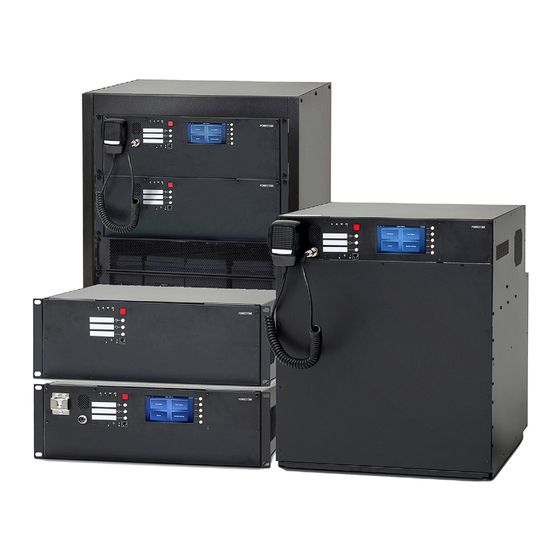
Table of Contents
Advertisement
Quick Links
SEVEN SYSTEM
COMPACT ALL-IN-ONE PUBLIC ADDRESS AND
VOICE ALARM SYSTEM
SISTEMA DE ALARMA POR VOZ Y MEGAFONÍA COMPACTO TODO EN UNO
SYSTÈME D'ALARME VOCALE ET PA COMPACT, MONTABLE EN RACK
SISTEMA DE ALARME POR VOZ E MEGAFONIA COMPACTO TUDO EM UM
INSTRUCTION MANUAL/MANUAL DE USUARIO/
MODE D'EMPLOI/MANUAL DE INSTRUÇÕES
Advertisement
Chapters
Table of Contents

Summarization of Contents
6. Requirements
6.1 Unpacking
Procedure for safely removing the product from its packaging to prepare for installation and use.
6.2 Installation requirements
Conditions for the alarm central unit room and environmental specifications for proper installation.
6.3 Environmental conditions
Guidelines for placing the product in suitable environments to ensure optimal performance and longevity.
7. Device description
7.1 Internal devices
Detailed description of the internal components that make up the SEVEN system, including control units.
8. System hardware installation
8.1 Information on limiting damage consequences
Guidelines to prevent potential issues and ensure safe installation of the system.
8.2 General connection diagram
Visual representation of how the SEVEN system components are interconnected for network operation.
8.3 Connecting devices
Instructions on how to connect various system components, including power, lines, and network devices.
9. Operation modes – LED colors
9.1 Normal mode
Description of the system's standard operational state when no faults or locks are present.
9.2 Alarm mode
Details on system behavior during an alarm, including device disconnection and automatic zone activation.
9.3 Failure mode
Information on how the system indicates and manages faults, including LED signals and confirmation procedures.
9.4 Lock mode
Explanation of how VASCU can lock and unlock system zones, preventing messages until unlocked.
10. Instruction for performing tests and trials
10.1 Instructions for performing basic functions
Step-by-step guidance for testing fundamental system operations and functions.
10.2 Testing the system
Comprehensive checks to verify the overall efficiency and proper operation of the VAS central unit.
11. Operation instructions
11.1 Control Unit
How to navigate and operate the SEVEN system via the touch-screen LCD and control buttons.
11.2 Fireman microphone
Instructions for authorized personnel on operating the fireman microphone for sending messages and activating alarms.
11.3 Zone microphone
Guidance on using the zone microphone for public announcements, zone selection, and audio source assignment.
12. Maintenance and service
12.1 Preparations before VAS system maintenance works
Initial procedures and considerations before commencing system maintenance and testing.
12.2 System maintenance
Procedures and checks for routine system maintenance, including daily reviews and periodic inspections.
13. Configuration Software
13.1 Welcome screen
Introduction to the SEVEN configuration software interface and initial project setup options.
13.2 Basic Configuration
Configuration of fundamental system settings, including project details, language, and time synchronization.
13.3 System Configuration
Detailed configuration of system elements, connections, and component allocation within the workspace.
13.4 Priority Manager Configuration
Setting priorities for audio sources to ensure correct operation during conflicts and system events.
13.5 Group Zone Configuration
Function to combine speaker lines or zones into groups for simplified system management and operation.
13.6 Control I/O Configuration
Configuration of logical inputs, outputs, and timers for system control and automation.
13.7 Matrix Configuration
Creating connections between audio sources and audio outputs for routing audio signals to speaker zones.
13.8 Scenario Configuration
Creating time-limited event sequences, executing sub-scenarios, and assigning matrices and logic outputs.
13.9 Event Configuration
Assigning system functions to logical inputs, buttons, and system states like Alarm Mode or Error.
13.10 The Amplifier Output Manager Tab
Verifies and manages amplifier output configuration for speaker line loads, ensuring safe operation and distribution.
13.11 Reports
Accessing system reports including audio routing, logical outputs, messages, and component summaries.
13.12 Basic steps required to program the system
Step-by-step guide for basic SEVEN configuration to make the system fully operational.
13.15 Appendix
13.15.1 AutoStandby mode
Explanation of the AutoStandby mode, its purpose, and operational principles for power saving.
14. SEVEN system touchscreen user manual
14.1 Home screen (screen saver)
Description of the idle status display showing system status, control unit name, date, and time.
14.2 Lock screen
Procedure for setting and using a password to access the system's touch screen interface.
14.3 System Options
Configuration of system settings including language, time zone, and display information.
14.4 Fire zones
Allows matrixing audio messages to selected zones and viewing zone status like failure or blocks.
14.5 Numerical selection of fire zones
Method for selecting fire zones using three-digit numbers, requiring specific zone naming conventions.
14.6 Fire zone groups
Function to view and manage predefined fire zone groups, including checking, starting, or stopping associated timers.
14.7 Service
Access to basic functionalities for system servicing, including impedance viewing, saving references, and code generation.
14.8 Fault register
View current system damages, failure history, sort entries, confirm, and clear faults.
14.9 Interface setting
Setting display language, time zone, and remote server information for the system interface.




Need help?
Do you have a question about the SEVEN-640 and is the answer not in the manual?
Questions and answers